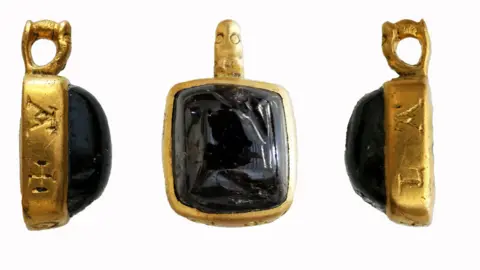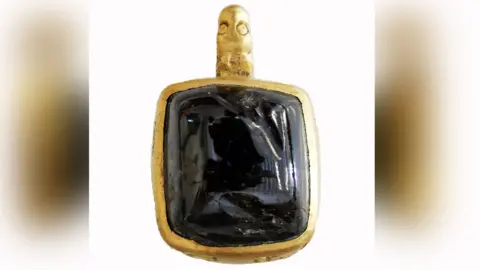Great Tey: Medieval pendant with 'magical' Hebrew words found
 Surrey County Council
Surrey County CouncilA medieval gold and garnet pendant inscribed with a "magical" Hebrew phrase has been declared treasure.
The jewel was discovered by a metal detectorist at Great Tey near Colchester, Essex, in August 2021.
The pendant is inscribed with an abbreviation of a Hebrew phrase meaning "Thou are mighty forever O Lord".
County finds liaison officer, Lori Rogerson, said its "noble" wearer was "invoking the protection of God in the most magically-powerful language".
 Surrey County Council
Surrey County CouncilThe late 12th or early 13th Century object is inscribed with the letters AGLA, which is an abbreviation of the phrase Atha Gebri Leilan Adonai.
This inscription has been found on a range of medieval jewels, said Surrey liaison officer Simon Maslin in his report for the Essex coroner.
Miss Rogerson said: "For medieval Christians, Hebrew was the language of magic, being an ancient language originating from a place with a long tradition of magical practice.
"So the phrase could be seen as doubly powerful by invoking the protection of God in the most magically-powerful language."
This was also a time of rising levels of anti-Semitism - which in England would culminate in Edward I expelling Jewish people from his kingdom in 1290 - so for some Christians, Hebrew was connected to the devil.
 Surrey County Council
Surrey County CouncilMiss Rogerson said "the line between magic and religion were very much blurred" for medieval people.
"This may seem surprising since magic and witchcraft tend to be associated with evil," she said.
"However, this is the legacy of the witchcraft hysteria of the 17th Century, when innocent people were accused of colluding with the devil."
Medieval gemstone pendants were much rarer finds than "very, very common" gemstone set finger rings, said Miss Rogerson.
"And the gemstone added an extra layer of magical protection to the wearer.
"As a creation of God, they were considered to be natural talismans due to their brilliant colour and purity."
Colchester Museum hopes to acquire the find.

Find BBC News: East of England on Facebook, Instagram and Twitter. If you have a story suggestion email [email protected]
